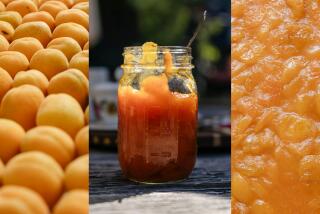Biting the Ham That Feeds You
- Share via
There was a time, in some ancient Greek and Roman circles anyway, when the phrase “You act like a pig!” would have been considered a compliment. As the authors of “The Complete Pork Cook Book” point out, the pig is a proud animal of “charm, good looks and sagacity”--that’s penetrating intelligence and sound judgment. That book also admires the pig for its amiable temperament . . . and “as a source of fine eating.”
At least as far back as 5000 B.C., the pig has been domesticated and its meat used as both a flavoring agent and major feasting dish. Party hosts often went for the whole hog--few things could impress a table of medieval revelers more than the sight of a whole roasted pig. (Well, maybe the trumpeted grand entrance of a stuffed peacock in all its plumage, but peacock meat is notoriously tough.)
These days, though, a whole ham is plenty impressive. Many consider the ham the best part of the pig--even those who are partial to bacon must admit that ham is incredibly versatile. You can bake it, fry it, boil it, spice it up, eat it plain, put it under pastry, or just between two slices of bread.
Here, for instance, are several examples of ham’s adaptability. There’s a showy-looking stuffed ham that would pretty up any Easter table. There’s a 2nd-Century Roman recipe for ham with figs. There’s crisp, skilled-seared ham with a red-wine sauce. There are three Spanish recipes: a vegetable-ham medley, one with lamb, and one with fish. There’s even a recipe in which the ham gets stuffed in dates.
Of course, these aren’t just ham recipes for Easter. As “The Smithfield Cookbook” puts it, “There is hardly an occasion from christening to funeral that does not call for getting down a ham.”
Claudia McQuillan, Bristol Farms’ executive chef and cooking school director, makes a perfect party ham. She cuts deep slits in a fully - cooked ham, stuffs in finely chopped greens, and pours on wine and honey. The stuffing gives the ham a fresh, spring-like appearance, and the deep scoring makes it easy to cut small slices so guests can help themselves at a buffet. McQuillan varies the stuffing, changing the wine to complement each mixture. And sometimes she bastes the ham with dry white wine and apricot jam or cherry preserves instead of honey.
CLAUDIA MCQUILLAN’S STUFFED EASTER HAM
1 (6- to 7-pound) smoked ham shank with bone in
1 bunch spinach
1 bunch parsley
Tops of 1 bunch green onions, washed and dried
2 cups Cabernet Sauvignon
2 cups honey
With sharp knife, trim skin from top of ham. Score ham in 2-inch intervals, cutting 2 inches into ham.
Wash and dry spinach, parsley and green onions. Remove stems from spinach and parsley. Cut green onion tops into 1-inch lengths. Combine spinach, parsley and green onion tops in food processor. Process with pulsing motion until finely chopped.
Stuff mixture into scoring on ham, fitting in as deeply as possible. Place ham in roasting pan. Mix wine and honey and pour over ham. Pat any remaining stuffing over back of ham.
Bake at 350 degrees 30 to 45 minutes, basting every 10 to 15 minutes, until ham is heated through and deeply colored. Remove from oven and place on carving board. Allow to stand 10 minutes before carving. Serve hot or at room temperature. Makes 10 servings.
Variation:
Substitute 1 bunch watercress, 1 bunch Italian parsley and 1 bunch chives for spinach, parsley and green onion tops. Make with Port wine and honey.
Each serving contains about:
650 calories; 4,164 mg sodium; 142 mg cholesterol; 16 grams fat; 59 grams carbohydrates; 62 grams protein; 0.46 gram fiber; 22% calories from fat.
The 2nd-Century Roman cookbook “De Re Coquinaria” gives a recipe for ham boiled with figs. Barbara Flower and Elisabeth Rosenbaum suggest the following proportions for it in their translation, “The Roman Cookery Book” (Harrap). “Even without the subsequent baking,” they comment, “the flavour is delicious.”
(Incidentally, here is the original Latin recipe: “Pernam, ubi eam cum Caricis plurimis elixaveris et tribus lauri foliis, detracta cute tesselatim incides et melle complebis. Deinde farinam oleo subactam contexes et ei corium reddis et, cum farina cocta fuerit, eximas furno et ut eat inferes.” Pass it on.)
PERNA ELIXA CUM CARICIS (Ancient Roman Ham With Figs)
1 (3-pound) precooked ham
1/2 pound dried figs
3 bay leaves
Water
1/4 cup honey
Pastry Crust
Place ham in pot with figs, bay leaves and enough water to cover by 1 inch. Bring water to boil and simmer until ham is heated through.
Take ham from pot, remove skin and make crisscross incisions as deeply as possible 1 1/2 to 2 inches apart all over surface of meat. Rub honey generously into cuts.
Make Pastry Crust and roll out 1/2 inch thick. Cover ham with pastry. Roll out remainder of pastry, if desired, and cut out shapes to decorate ham. Press decorations lightly onto pastry crust. Bake at 350 degrees 1 hour, or until crust is brown. Remove ham from oven and let cool. Carve and serve. Makes 8 servings.
Each serving contains about:
1,051 calories; 2,950 mg sodium; 97 mg cholesterol; 70 grams fat; 67 grams carbohydrates; 44 grams protein; 1.49 grams fiber; 60% calories from fat.
Pastry Crust
3 1/4 cups flour
2 teaspoons salt
2 cups oil
1/2 cup cold water
In large mixing bowl, combine flour and salt and make well in center. Add oil and mix well to incorporate. Mix in water, 1/4 cup at time, until dough forms. Makes enough for 1 ham and cut-out decorations.
A dish eaten all over Spain.
GUISANTES CON JAMON
6 tablespoons olive oil
1 medium onion, chopped
6 ounces ham, cut into strips
1 cup shelled peas
1 head lettuce, chopped
Pour olive oil in heavy casserole. Add onion and fry over medium heat until golden. Add ham, peas and lettuce. Cover and simmer few minutes until heated through. Serve as side dish with meat. Makes 4 servings.
Each serving contains about:
418 calories; 565 mg sodium; 23 mg cholesterol; 25 grams fat; 32 grams carbohydrates; 19 grams protein; 4.71 grams fiber; 53% calories from fat.
A typical dish of a festival that takes place annually in the small town of Almonte, between Huelva and Sevilla in Andalusia. From “Spanish Cookery” by Ursula Bourne.
CALDERETA
6 ounces ham, diced
3 large onions, sliced
4 cloves garlic, chopped
6 black peppercorns
Salt
2 pounds boneless lamb, cut in stewing cubes
1 teaspoon olive oil
3/4 cup dry white wine
1/2 cup water
1 bay leaf
Mix ham, onions, garlic and peppercorns. Season to taste with salt. Place layer of ham mixture on bottom of heavy casserole, cover with layer of lamb, and continue alternating layers, ending with layer of ham mixture. Sprinkle with olive oil, wine and water and insert bay leaf.
Cover casserole and bake at 300 degrees until lamb is done, about 3 hours. Remove bay leaf and serve. Makes 4 servings.
Each serving contains about:
450 calories; 772 mg sodium; 170 mg cholesterol; 17 grams fat; 10 grams carbohydrates; 55 grams protein; 0.55 gram fiber; 34% calories from fat.
One of the best-known Spanish dishes. This version is from “Adventures in Taste: The Wines and Folk Foods of Spain” by D. E. Pohren.
TRUCHA A LA NAVARRA
4 (1-pound) large trout
4 (2-ounce) slices cooked country ham
Flour
1/4 cup olive oil
Salt, pepper
1 lemon, sliced
If fish are not cleaned, slit open stomachs and remove intestines and gills. Wash thoroughly and wipe dry. Insert ham (in whole slices or chopped) into trout.
Season fish to taste with salt and pepper and dredge in flour. Heat olive oil in heavy skillet until hot but not smoking. Arrange whole trout, without touching, in skillet. Fry until crisp and golden brown on both sides, shaking pan often. Garnish plate with lemon slices. Makes 4 servings.
Each serving contains about:
468 calories; 1,670 mg sodium; 122 mg cholesterol; 28 grams fat; 6 grams carbohydrates; 46 grams protein; 0.02 gram fiber; 53% calories from fat.
This is just one of the down-home and completely delicious recipes from “Slow Food: Flavors and Memories of America’s Hometowns,” a cookbook by Michael James that will be published next month by Warner Books.
MICHAEL JAMES’ CRISP HAM SLICES IN RED WINE
6 tablespoons olive oil
6 baked ham slices, about 1/3-inch thick, at room temperature
1/2 cup finely chopped onion
Salt
Freshly ground pepper
1 1/2 cups Pinot Noir or Zinfandel
Set 2 large skillets over high heat and add 2 tablespoons olive oil to each pan. When oil is hot, add as many ham slices as will fit in pans. Do not crowd. Sear about 2 minutes on 1 side, pressing on meat so slices brown evenly. Turn slices and sear about 1 minute. Remove to platter and keep warm while browning rest of ham.
Add remaining 2 tablespoons olive oil to 1 skillet set over medium-low heat. Add onion, salt and pepper to taste and stir to coat onion with oil. Cover and cook 4 or 5 minutes, stirring occasionally. Uncover, add wine and boil down rapidly over high heat, until there is about 1/2 cup liquid in pan. Scrape sides and bottom of skillet to dissolve any caramelized meat juices. Season to taste with salt and pepper. Pour sauce over ham slices. Season to taste with pepper. Makes 6 servings.
Each serving contains about:
313 calories; 1,675 mg sodium; 53 mg cholesterol; 19 grams fat; 3 grams carbohydrates; 22 grams protein; 0.08 gram fiber; 55% calories from fat.
The sweet and salty mingle pleasantly in this tasty version of a popular appetizer.
HAM-STUFFED DATES
1 cup minced ham
2 teaspoons minced fresh rosemary leaves
1 clove minced garlic
1/4 cup toasted pine nuts, chopped
1 (3.5-ounce) package goat cheese, cut-up
18 large dates, preferably Medjool
9 slices bacon, cut in halves
Combine ham, rosemary, garlic, pine nuts and goat cheese. Cut 1 side of each date open. Remove pit. Stuff each date with about 1 heaping teaspoon filling. Press to close. Wrap each date with 1/2 slice bacon. Press to seal edge. Broil until bacon is dark brown and crispy, turning to cook all sides. Makes 18 appetizers.
Each appetizer contains about:
136 calories; 227 mg sodium; 16 mg cholesterol; 10 grams fat; 10 grams carbohydrates; 4 grams protein; 0.25 gram fiber; 64% calories from fat.
This would be a perfect accompaniment to just about any ham dish. The recipe was contributed by Michelle Min - Green.
ROASTED BALSAMIC ONIONS
4 medium red onions
8 slices bacon
1 cup balsamic vinegar
Salt, pepper
Peel red onions and slice 3/4 way through horizontally. Wrap each onion with 2 slices of bacon each, circling onion vertically.
Place onion in center of large sheet of foil. Gently pull edges around onion to form shallow cup. Pour 1/4 cup balsamic vinegar over onion. Season to taste with salt and pepper. Tightly encase onion in foil, trying not to let any liquid escape. Wrap foil-encased onion once more with second sheet of foil very tightly so it’s leak-proof. Repeat procedure with remaining onions.
Bake onions at 350 degrees on baking sheet at least 1 hour--no more than 1 hour, 15 minutes. Shake tray occasionally to toss onions, ensuring even cooking. When done, onions will be very tender and caramelized. Serve warm as side dish or appetizer. Makes 4 servings.
Each serving contains about:
297 calories; 408 mg sodium; 30 mg cholesterol; 26 grams fat; 12 grams carbohydrates; 5 grams protein; 0.59 gram fiber; 79% calories from fat.


